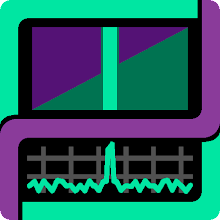Setup
For this demonstration two instances of baudline's Tone Generators were used to create a sine wave on the left channel and an FM modulated triangle wave on the right channel. This multiple channel manipulation was done with CoreAudio but JACK could of accomplished the same test system.

Next the x * y multiplication operation in the Input Mapping window was used to mix the left and right channels to create a single modulated channel.

The new synthesized channel was then run through the Waveform window, the Fourier transform, and both the magnitude and phase spaces of the blip Fourier transform.
Waveform
The time domain samples are displayed in the Waveform window. The FM sweep and the AM beats are visible.

Fourier magnitude
The frequency domain is displayed with the Spectrogram window using the standard Fourier transform. The main FM triangle shape is visible.

Note that the timebase is 1/64X so this is fairly deep zoom with each spectral slice representing less than 3 samples.
blip Fourier magnitude
The same spectrogram display and magnitude space as above but with the blip Fourier transform. Note the sharper edges, grid on the FM triangle, and the enhanced detail in the noise floor.

The grid pattern is not a DSP artifact but in fact amplitude beats which are a unique feature of the signal.
blip Fourier phase
This is the same spectrogram display of the blip Fourier transform as above but of the phase space. This means that the spectrogram's color axis and the spectrum's vertical axis are not dB magnitude but instead represent phase in radians (±pi). The main signal features are the same but the blind phase locking creates interesting patterns that show how the phase is changing.

The diamond/triangular shaped blocks are not beats in this view space but phase modulation (PM) created by the x*y operation. The second harmonic of the FM triangle shape has a similar phase structure. Beneath that are folded aliasing and other distortion products. It appears that the fabric of phase space is a layered summation of signals with the most prominent on top. The zebra-like ripples around the main signal elements have a rich complexity and will be studied further in a future blog post.
Conclusion
The blip Fourier transform is an enhanced view into the frequency domain that has many powerful uses. The phase and fine sample details of signals can be explored and analyzed in ways previously not possible. As amazing as the blip transform's blind phase locking algorithm is, it is not without its faults since the process does create some additional distortion which lowers the system SNR. So the blip Fourier transform is great for deep low-level zooming and fine structure examination but it is not suitable for weak signal work. It is not a replacement for the Fourier transform but instead an additional transform for the DSP toolbox.
